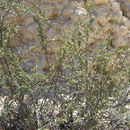en
names in breadcrumbs


Nile region, Oases, Mediterranean region, Egyptian desert, Res Sea coastal strip, Gebel Elba, Sinai (St.Katherine) and Napq.
North Africa, Sinai, Palestine, Syria, Arabia, Iraq, Iran, Pakistan.
Nitraria retusa, commonly known as Nitre bush, is a salt-tolerant and drought-resistant shrub in the family Nitrariaceae.[1] It can grow to heights of 2.5 metres (8 ft 2 in), although it seldom exceeds more than 1 m in height. It produces small white/green coloured flowers [2] and small edible red fruit.[3] The plant is native to desert areas of northern Africa, where it grows in primary succession on barren sand dunes,[4] and in areas with high salinities such as salt marshes.
Nitraria retusa is a bush growing to a maximum height of about 2.5 m (8 ft). The twigs are furry when young, with the bluish-grey fleshy leaves being alternate, wedge or sickle-shaped, with entire margins and measuring 10 to 15 mm (0.4 to 0.6 in) by 8 to 10 mm (0.3 to 0.4 in). The small, sweetly-scented, whitish or greenish flowers have short pedicels and parts in fives. The fruit is a triangular drupe, 5 to 10 mm (0.2 to 0.4 in) in diameter.[2]
This plant is native to North and East Africa, the Arabian Peninsula and the Middle East. It typically grows in salt marshes and semi-arid saline areas of deserts and it can help in the stabilisation of loose soils.[5]
In the Moghra Oasis, N. retusa plays an important role in the stabilisation of sand dunes. Here it is the dominant plant in some zones, forming hummocks known as nabkhas, where windblown materials heap up at the base of the plants. It shows a range of tolerances toward soil salinity and the availability of water. Near the lake, where salinity is low and the water table high, it associates with the sea rush, the common reed, salt grass and Zygophyllum album. At the outer fringe of the vegetated zone, where the salinity is high and the water table deep, it grows with Z.album and the Nile tamarisk.[6]
The fruit turns red as it ripens and is enjoyed by humans and wildlife, which spread the seed.[7] Camels and goats feed on the succulent leaves of this plant and desert-dwellers have used it as a source of salt. The wood is used for fuel and the fruits are sometimes used to make an intoxicating drink.[5] N. retusa is one of a number of salt-tolerant plants that are being investigated as potential fodder crops for livestock.[8]
Nitraria retusa, commonly known as Nitre bush, is a salt-tolerant and drought-resistant shrub in the family Nitrariaceae. It can grow to heights of 2.5 metres (8 ft 2 in), although it seldom exceeds more than 1 m in height. It produces small white/green coloured flowers and small edible red fruit. The plant is native to desert areas of northern Africa, where it grows in primary succession on barren sand dunes, and in areas with high salinities such as salt marshes.